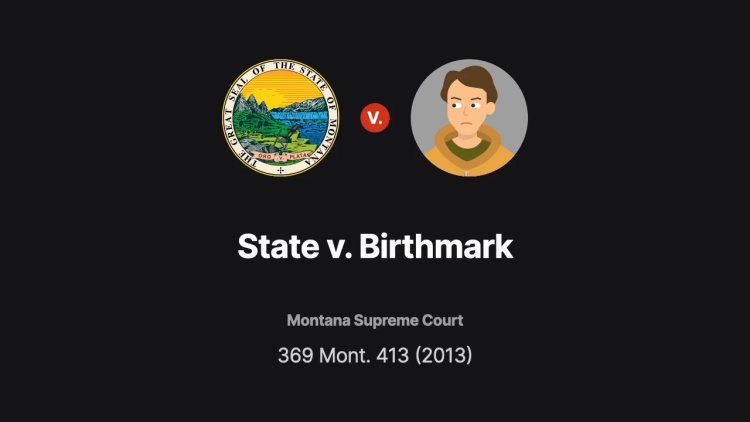State v. Birthmark
Montana Supreme Court
369 Mont. 413 (2013)
- Written by Abby Roughton, JD
Facts
Michael Todd Birthmark (defendant) was staying in his mother’s home with his mother, brother, and sister. One evening, Birthmark and his sister attended a party at their aunt’s home, but Birthmark got into an argument at the party and returned home at 1:30 a.m. without his sister. Birthmark was angry and intoxicated, and he called his mother and brother names; picked up a large stick; talked about finding a knife; and threatened to kill his mother, his brother, and the people at the party. When Birthmark went to look for a knife, his mother called 911. A police officer reported to the home and found Birthmark’s mother crying and extremely frightened. Birthmark came out of the house unarmed at the officer’s request, but the officer noticed that Birthmark was intoxicated and angry. The State of Montana (plaintiff) charged Birthmark with Partner or Family Member Assault (PFMA) for purposely or knowingly causing reasonable apprehension of bodily injury in his mother and brother. At trial, Birthmark testified that he had been attacked at the party and was concerned for his sister. Birthmark further testified that although his mother and brother had assumed that his threats were directed at them, he had actually been angry at the party guests, not his mother and brother. In instructing the jury on PFMA, the trial court explained that an act is committed purposely if the actor has the conscious object to engage in the conduct and that an act is committed knowingly if the actor is aware of his or her conduct. The jury ultimately found Birthmark guilty, and the court sentenced him to prison. Birthmark appealed, arguing that the trial court should have instructed the jury that the prosecution needed to prove that Birthmark had intended for his actions to cause his mother and brother reasonable apprehension of bodily injury.
Rule of Law
Issue
Holding and Reasoning (McGrath, C.J.)
What to do next…
Here's why 899,000 law students have relied on our case briefs:
- Written by law professors and practitioners, not other law students. 47,000 briefs, keyed to 994 casebooks. Top-notch customer support.
- The right amount of information, includes the facts, issues, rule of law, holding and reasoning, and any concurrences and dissents.
- Access in your classes, works on your mobile and tablet. Massive library of related video lessons and high quality multiple-choice questions.
- Easy to use, uniform format for every case brief. Written in plain English, not in legalese. Our briefs summarize and simplify; they don’t just repeat the court’s language.





